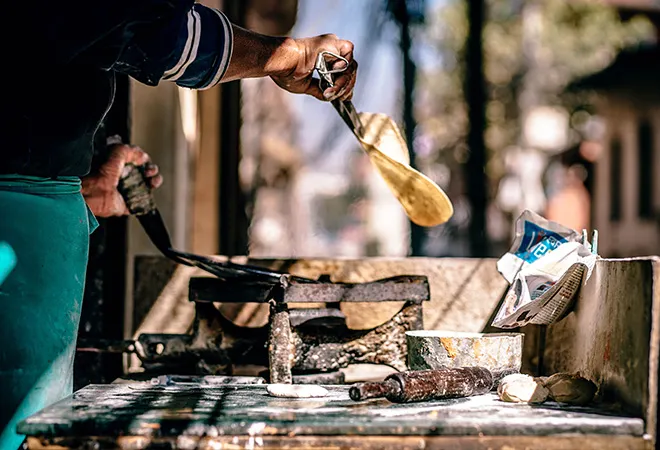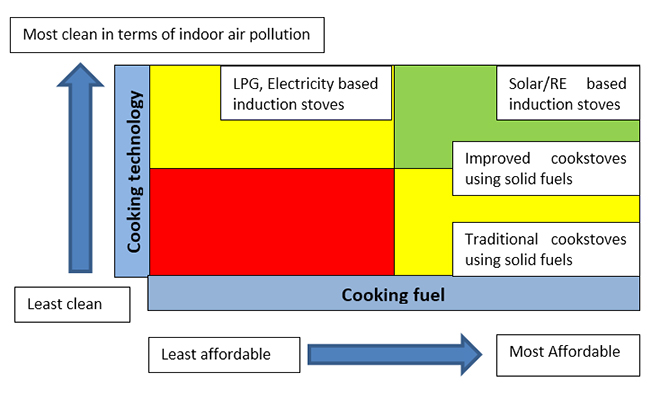
India played a prominent role in development of Sustainable Development Goals (SDG). The SDG 7 ensures access to affordable, reliable, sustainable and modern energy for all. One among the three indicators of SDG 7 is to ensure usage of clean cooking fuel to 100% households by 2030. However, the SDG India dashboard indicates that only 43.80% households use clean cooking fuel, i.e., India needs to cover around 56% households in next 11 years. Majority of the households lacking clean cooking fuel are located in rural India.
Fuel stacking is a common practice followed in rural India, wherein the households depend on more than one fuel for cooking. One among these fuels becomes the primary fuel. Census of India (2011) reported firewood as the primary cooking fuel among 63% of the rural households while another 23% used crop residues and cowdung cakes as cooking fuels. Only 11% rural households were using Liquefied Petroleum Gas (LPG) as primary cooking fuel. Survey conducted from 2015 to 2018 by Council for Energy, Environment and Water (CEEW) concluded that the share of households (in six major energy access deprived states) using LPG as their primary cooking fuel increased from 14 to 37% (CEEW, As on May 2019). The rate of increase in usage of LPG as primary cooking fuel has been slow in spite of introducing schemes like Deepam, Rajiv Gandhi Gramin LPG Vitrak Yojna & Pradhan Mantri Ujjwala Yojna.
Fuel stacking is a common practice followed in rural India, wherein the households depend on more than one fuel for cooking. One among these fuels becomes the primary fuel. Census of India (2011) reported firewood as the primary cooking fuel among 63% of the rural households while another 23% used crop residues and cowdung cakes as cooking fuels.
The present article draws a common thread from the assessments of major clean cooking initiatives since 1980s and suggests relooking at the clean cooking initiatives designed for rural India.
Solid fuels (a collective term used for firewood, crop residues and dung cakes) are generally available free of cost although the users need to make efforts in terms of collection and storage. Inefficient burning of solid fuels in traditional mud-stoves leads to household air pollution posing adverse impact on health of the cook especially in enclosed spaces. To overcome this drawback, concerted efforts to introduce improved cook-stove technologies began during 1980s by the Ministry of New and Renewable Energy (MNRE). The adoption of improved cook-stove technologies remained a challenge as more than switching to new cook-stoves people stacked devices and fuels based on the preferred combinations for the main cooking tasks (Ruiz-Mercado, Masera, Zamora, & Smith, 2011). User friendliness of the technology and availability of repair and replacement services are also important in adoption of these stoves<1>.
The adoption of improved cook-stove technologies remained a challenge as more than switching to new cook-stoves people stacked devices and fuels based on the preferred combinations for the main cooking tasks.
Clean cooking programmes based on solar and biogas were also introduced during 1990s at various pockets of the country. The issue of feed and maintenance remained the major challenge for adoption of household biogas plants for cooking. Solar cooking has its own limitations in terms of time required for cooking. Thus, the households continued to depend on solid fuels for cooking.
Subsidies on LPG in India were introduced in late 1960s. In rural India, both users and non-users hold positive views of LPG as a convenient and clean cooking fuel. However, the cost of stove and cylinders has always remained the major barrier towards adoption of LPG (Goulda & Urpelainen, 2018). In addition, availability of LPG in the LPG stations and difficulties such as transportation faced by the rural LPG connection holders while refuelling of the LPG cylinders also remains a challenge among users<2>. A study conducted by Research Institute for Compassionate Economics, mentions that 90% of Ujjwala beneficiaries (the scheme launched in the year 2016 where subsidized LPG connections were provided to women of the poor households) still use solid fuels for cooking (Times of India, Published on May 2 2019). The primary reason is reported as the affordability and availability of solid fuels compared to LPG.
In rural India, both users and non-users hold positive views of LPG as a convenient and clean cooking fuel. However, the cost of stove and cylinders has always remained the major barrier towards adoption of LPG.
The Energy and Resources Institute (TERI) after conducting primary survey of induction stove users in 1000 rural households concluded that electricity replaced LPG as the secondary cooking fuel in 84% households and solid fuel remained the primary fuel (Banerjee, Prasad, Rehman, & Gill, 2016). The convenience of cooking using induction stoves were also reported by the users. However, the point of electricity as a cooking option still needs massive investments in terms of infrastructure.
The assessment results of all the clean cooking initiatives since 1980s for rural India has a common thread – the norm is to depend on the solid fuels for cooking and use the clean cooking fuel / technology as a secondary/tertiary cooking option. Solid fuels and traditional cookstoves remained the most popular fuel and cooking technology in the rural areas mainly due to two reasons – availability and affordability, in spite of realizing the conveniences associated with LPG and induction stoves. Households do not find firewood collection inconvenient, but they are dissatisfied if they have to travel long distance to purchase firewood (Baquié & Urpelainen, 2017).
Learning from the past, we need to re-look at initiatives and assessment criteria of the clean cooking programmes for rural areas. The programmes need to focus on more than one (about two to three) cooking fuel and technology combinations. One among the technology has to resemble the existing cooking practices and the other has to be the cleaner cooking technology. For example, a programme can introduce a natural draft improved cookstove along with LPG. The combinations may be introduced based on the cooking technologies used in the area, economic status of the households, affordability of the clean cooking fuel, availability of solid fuels, connectivity to the LPG refilling stations, and electricity access scenario of the area. The matrix below provides the combination options for cleaner cooking technologies and affordable fuels. The matrix also includes Renewable (RE) based induction cooking option though the technology is at very nascent stage.
Learning from the past, we need to re-look at initiatives and assessment criteria of the clean cooking programmes for rural areas. The programmes need to focus on more than one (about two to three) cooking fuel and technology combinations.
 Figure: Combination options for cleaner cooking technologies and affordable cooking fuels (Source: Author)
Figure: Combination options for cleaner cooking technologies and affordable cooking fuels (Source: Author)
In similar lines, the assessment criteria of the clean cooking initiatives have to be in relative terms. The increase in share of usage of cleaner and cleanest cooking technology from the baseline has to be one of the criteria to define success of the clean cooking initiative.
The assessment criteria of the clean cooking initiatives have to be in relative terms. The increase in share of usage of cleaner and cleanest cooking technology from the baseline has to be one of the criteria to define success of the clean cooking initiative.
Fuel stacking is a common practice and rural households continue to depend on solid fuels in spite of realizing the convenience of cooking with LPG and induction stoves. The rural households returned to traditional stoves when improved cookstove, biogas and solar cookers were introduced for cooking. More than one factor plays as a barrier to complete adoption of cleaner cooking fuels and technologies. To ensure sustained usage of clean cooking fuel, it is suggested that about two to three cleaner cooking technologies need to be introduced in any clean cooking initiative. This will help in increasing the share of actual usage of cleaner cooking technologies among the rural households compared to their existing baseline.
References:
Banerjee, M., Prasad, R., Rehman, I. H., & Gill, B. (2016, January). Induction stoves as an option for clean cooking in rural India. Energy Policy, 88, 159-167.
Baquié, S., & Urpelainen, J. (2017, June). Access to modern fuels and satisfaction with cooking arrangements: Survey evidence from rural India. Energy for Sustainable Development, 38, 34-47.
CEEW. (As on May 2019).
Goulda, C. F., & Urpelainen, J. (2018, November). LPG as a clean cooking fuel: Adoption, use, and impact in rural India. Energy Policy, 122, 395-408.
Ruiz-Mercado, I., Masera, O., Zamora, H., & Smith, K. R. (2011, December). Adoption and sustained use of improved cookstoves. Energy Policy, 39(12), 7557-7566.
Times of India. (Published on May 2 2019).
<1> Based on Author’s interaction with the users
<2> Based on author’s interaction with the users
The views expressed above belong to the author(s). ORF research and analyses now available on Telegram! Click here to access our curated content — blogs, longforms and interviews.




 Figure: Combination options for cleaner cooking technologies and affordable cooking fuels (Source: Author)
Figure: Combination options for cleaner cooking technologies and affordable cooking fuels (Source: Author) PREV
PREV


